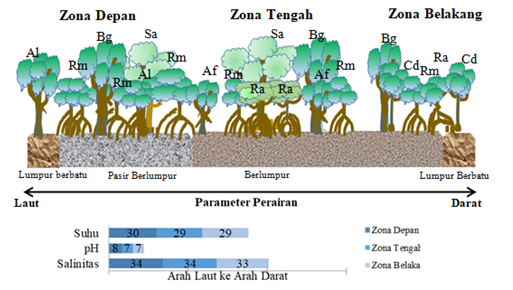Pattern Zone Ecosystem of Mangrove in Juanga Village, Morotai Island District
DOI:
https://doi.org/10.46252/jsai-fpik-unipa.2020.Vol.4.No.1.92Keywords:
zonning pattern, mangrove ecosystem, MorotaiAbstract
ABSTRACT
Mangroves are one of the most important natural resources in coastal areas. Availability of various types of food that are on ecosystems is already making its presence as a local nursery, where searching for eating and also serve as a regional tourist ecosystem of mangrove. In use as Regional tourist mangrove need to attention the condition of the physical environment and the distribution pattern of zoning. Research is carried out in the month October to November 2019 in the village of Juanga Regency island of Morotai. Data zoning mangrove using the method of the combination is to combine the methods of plots to track transects, to determine the four stations of observation of each respective stations and each station is divided into three zones: zone front, zone of middle and zone back starting from the point of the outermost growth of types of mangrove constituent primary to the point of transition between sea and land. The research results of the study found 5 types of mangroves namely Rhizophora mucronata, Ceriops decandra, Rhizophora apiculata, Xylocarpus granatum and Sonneratia alba. The distribution of zoning patterns in the front zones of station I and the middle zone is dominated by Rhizophora mucronata and Rhizophora apiculata types, the rear zone is dominated by Ceriops decandra. Station II front zone is dominated by Sonneratia alba, middle zone (Rhizophora mucronata), rear zone (Ceriops decandra). At station III the front zone (Rhizophora apiculata), the middle zone and the rear zone (Ceriops decandra) while at station IV the front zone, the middle zone and the rear zone are dominated by the Ceriops decandra type.
Downloads
References
Bengen, D.G. 2004. Mengenal dan Memelihara Mangrove. Pusat Kajian Sumber Daya Pesisir dan Lautan IPB. Bogor.
Dahuri R. 2001. Pengelolaan Sumberdaya Wilayah Pesisir dan Lautan ecara Terpadu. Jakarta. PT:Pradnya Paramita
Irwanto. 2006. Keanekaragaman Fauna pada Habitat Mangrove. Yogyakarta.
Keputusan Menteri Lingkungan Hidup Nomor 5 .2014. Tentang Baku Mutu Air Limbah. Jakarta: Sekertariat Lingkungan Hidup.
Khazali, M. 2006. Panduan pengenalan mangrove PHKA/WI-IP. Bogor
Kolinug H. K, Langi A.M, Ratag P.S, Nurmawan W. 2014. Zonasi Tumbuhan Utama Penyusun Mangrove Berdasarkan Tingkat Salinitas Air Laut Air Laut Di Desa Teling Kecamatan Tombariri. Jurna Ilmiah Fakultas Pertanian Universitas Samratulangi (5):4 1-9
Koroy, K. 2012. Valuasi Ekonomi Hutan Mangrove dan Strategi Pengelaolaannya di Desa Sakam Kecamatan Patani Utara Kabupaten Halmahera Tengah. [Skripsi]. Program Studi Manajemen Sumberdaya Perairan, Fakultas Perikanan dan Ilmu Kelautan, Universitas Khairun. Ternate.
Kusmana, C. 1995. Manajemen Ekosistem Mangrove Indonesia. Lab Ekologi Hutan. Jurusan Manajemen Hutan, Fakultas Kehutanan, IPB. Bogor.
Mughofar A, Masyukuri M, Setyono P. 2018. Zonasi Dan Komposisi Vegetasi Hutan Mangrove Pantai Cengkrong Desa Karanggandu Kabupaten Trenggalek Provinsi Jawa Timur. Tesis Program Pascasarjana Universitas Sebelas Maret; Surakarta
Muhsin dan Indrawati. 2008. Distribusi dan Kepadatan Jenis Vegetasi Mangrove Menurut Tingkatan Pertumbuhan di Wilayah Pesisir Kabupaten Kolaka Provinsi Sulawesi Tenggara. Volume 16 Nomor 02 Juli: 128-136.
Noor, R., 2006. Panduan Pengenalan Mangrove di Indonesia. Wetland International Indonesia Programe. Bogor.
Noor, R.,M. Khazali, I.N.N. Suryaputra. 1999. Panduan Pengenalan Mangrove di Indonesia. Ditjen PHKA. WI-PI.Bogor.
Peterson CH. 1991. Intertidal zonation of marine invertebrates in sand and mud. Amer Sci 79: 236-249.
Sunarni, Maturbongs RM, Arifin T dan Rahmania R. 2019. Zonasi dan Struktur Komunitas Mangove di Pesisir Kabupaten Merauke. Jurnal Kelautan Nasional. Vol. 14, No 3, Desember 2019, Hal. 165-178



















